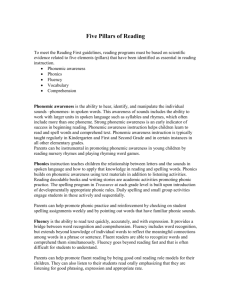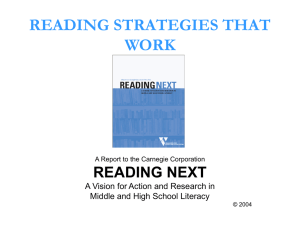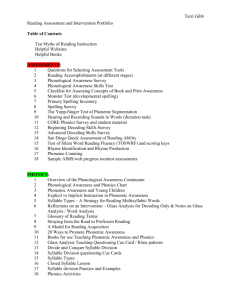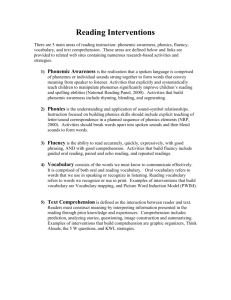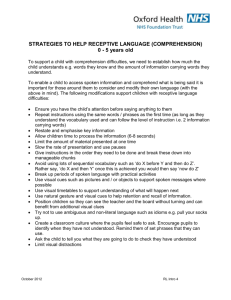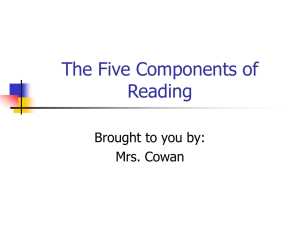Literacy Skills for Pre
advertisement
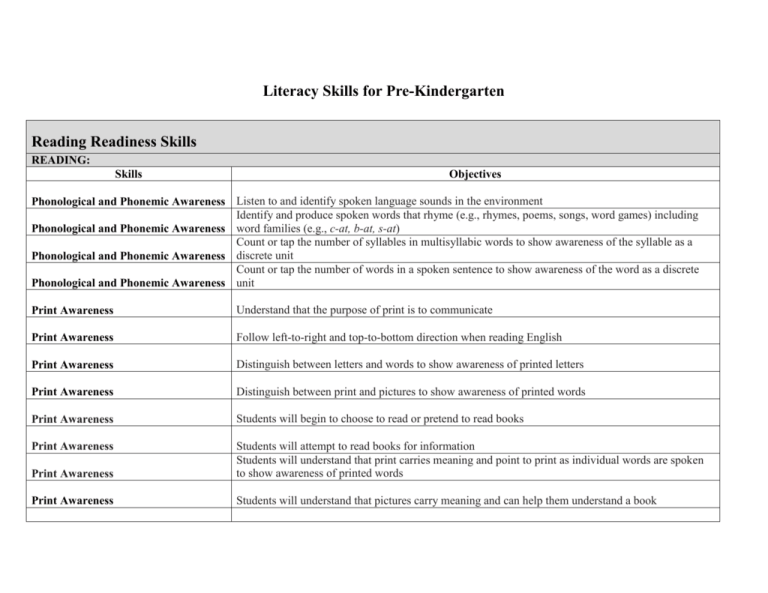
Literacy Skills for Pre-Kindergarten Reading Readiness Skills READING: Skills Objectives Phonological and Phonemic Awareness Listen to and identify spoken language sounds in the environment Identify and produce spoken words that rhyme (e.g., rhymes, poems, songs, word games) including Phonological and Phonemic Awareness word families (e.g., c-at, b-at, s-at) Count or tap the number of syllables in multisyllabic words to show awareness of the syllable as a Phonological and Phonemic Awareness discrete unit Count or tap the number of words in a spoken sentence to show awareness of the word as a discrete Phonological and Phonemic Awareness unit Print Awareness Understand that the purpose of print is to communicate Print Awareness Follow left-to-right and top-to-bottom direction when reading English Print Awareness Distinguish between letters and words to show awareness of printed letters Print Awareness Distinguish between print and pictures to show awareness of printed words Print Awareness Students will begin to choose to read or pretend to read books Print Awareness Print Awareness Students will attempt to read books for information Students will understand that print carries meaning and point to print as individual words are spoken to show awareness of printed words Print Awareness Students will understand that pictures carry meaning and can help them understand a book Alphabet Recognition and Phonics Students will be able to identify their uppercase letters Alphabet Recognition and Phonics Students will be aware of lowercase letters and be able to identify some, especially those in their name Alphabet Recognition and Phonics Students will identify two words after being given the letter name and sound. Reading Read own name Reading Recognize and identify environmental print including signs and labels Reading Background Knowledge and Vocabulary Development Background Knowledge and Vocabulary Development Background Knowledge and Vocabulary Development Background Knowledge and Vocabulary Development Students will attempt to read words from a chart or around the room Comprehension Strategies Show interest in reading for different purposes (e.g., gaining information about the world and others) Comprehension Strategies Make predictions about story events Comprehension Strategies Students will identify characters, emotions and actions Comprehension Strategies Retell stories with attentiveness to the sequence of events, main ideas and main characters Comprehension Strategies Ask and answer questions about the content of books Comprehension Strategies Students will make text to self connections Learn and use new words in spoken communication Learn new words from books Use new vocabulary words to talk about life experiences Connect vocabulary and life experiences to ideas in books Motivation to Read Show interest in a range of preschool-level texts, such as alphabet books, stories, poems, and informational texts Oral Language Students will begin to use language to tell needs and/or wants or thoughts Oral Language Students will respond to own name and request for action Oral Language Students asks and answers questions and given directions Oral Language Students will participate in dramatic play influenced by stories heard Oral Language Students will use language to develop relationships Oral Language Students will use language to tell a personal narrative Oral Language Students will use language to tell a personal narrative with a beginning, middle and end Oral Language Students will increase their vocabularies WRITING: Print Awareness Use left-to-right and top-to-bottom direction when writing English Print Awareness Use spacing between letters and words Spelling Use sound or invented spelling to spell independently Spelling Students will be able to print their first name Handwriting Write some uppercase and lowercase manuscript letters, especially those in own name Composition Students will draw a picture to express the event of a story Composition Label drawings with letters or words Composition Students will understand that we write for many purposes and print carries meaning Composition “Write” messages as part of play Composition “Write” by using painting, drawing, letters, and some words Motivation to Write “Write” and draw spontaneously to communicate meaning Motivation to Write Show interest in sharing writing and drawing with others

